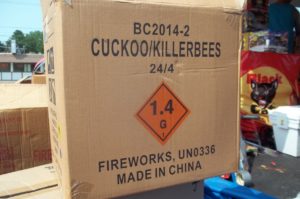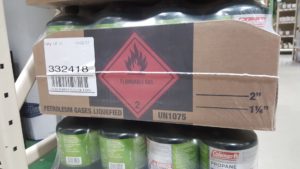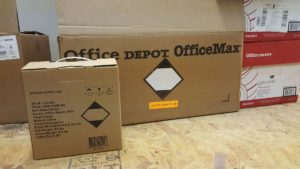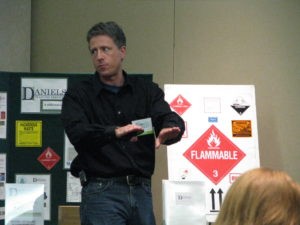The Hazardous Materials Regulations (HMR) of the USDOT/PHMSA applies to the transportation in commerce of all hazardous materials (HazMat) to, from, or through the U.S. As a rule these regulations apply equally to all HazMat. However, sometimes USDOT/PHMSA provides for an exception from full regulation if a shipper of HazMat can meet certain conditions. One such exception is the one allowing for the transportation in commerce of hazardous materials under the reverse logistics exception.
Understanding the reverse logistics exception requires knowledge of three distinct regulations in the HMR:
- The limited quantity section of a HazMat’s packaging exceptions (if it exists) in 49 CFR Part 173. Here some – not all – HazMat are explicitly authorized for reverse logistics transportation.
- The definition of reverse logistics at §171.8.
- The general requirements and exceptions for reverse logistics at §173.157.
This article will identify the reverse logistics exception and describe how it can be used to reduce a shipper’s responsibilities under the HMR.
|
Like this article? Subscribe to my Monthly Newsletter No marketing emails! |
Before we begin…
It might be a good idea to understand some terms used in the HMR and this article.
- A shipper of a HazMat is the person / business / government agency that prepares the HazMat for transportation and/or makes the HazMat available to the carrier. It’s a lot more complicated than that (read: Who is the Shipper When Transporting HazMat?) but that will do for moving forward. Also, it is possible for a consignment of a HazMat to have more than one shipper (LOI 18-0076).
- Hazardous waste is defined at §171.8: Hazardous waste, for the purposes of this chapter, means any material that is subject to the Hazardous Waste Manifest Requirements of the U.S. Environmental Protection Agency specified in 40 CFR part 262. In regular language it means any hazardous waste regulated by the USEPA and generated by a large quantity generator or small quantity generator.
|
Not sure of your hazardous waste generator status? Take this short survey |
- Special permit is also defined at §171.8. It allows both shippers and carriers to transport HazMat in a way not allowed by the HMR. Special permits have their own conditions, restrictions, & limitations that a holder of the special permit must comply.
Special permit means a document issued by the Associate Administrator, the Associate Administrator’s designee, or as otherwise prescribed in the HMR, under the authority of 49 U.S.C. 5117 permitting a person to perform a function that is not otherwise permitted under subchapter A or C of this chapter, or other regulations issued under 49 U.S.C. 5101 et seq. (e.g., Federal Motor Carrier Safety routing requirements).
Note:
Read more about Special Permits, Approvals, and Exceptions to the HMR
- Private carrier – despite its use in the HMR – is not clearly defined. This interpretation letter (02-0259, at the bottom of the first page) identifies it as a carrier who, “transports its own property for the purposes of sale, lease, or ‘in furtherance of any commercial enterprise.'” So, a private carrier transports its own HazMat for its own business.
- A non-private carrier is any carrier not meeting the definition of the private carrier. Any carrier transporting HazMat it doesn’t own for another party will be a non-private carrier. A non-private carrier includes a contract carrier and a common carrier.
- Limited quantity is defined at §171.8: Limited quantity, when specified as such in a section applicable to a particular material, means the maximum amount of a hazardous material for which there is a specific labeling or packaging exception. A full explanation requires a separate article, but a limited quantity is a packaging exception to full regulation under the HMR. Many – but not all – HazMat are authorized for the limited quantity exception.
Scope and Applicability Part 1: Conditions
The reverse logistics exception is authorized under the following conditions:
- For highway transport by motor vehicle only.
- It may be used solely within the U.S. Regulations of the International Air Transport Association (IATA) and the International Maritime Organization (IMO) do not include the reverse logistics exception.
- The HazMat and its transport must meet the definition of reverse logistics at §171.8 (see later in this article).
- Hazardous waste is not authorized for the reverse logistics exception.
- HazMat subject to a special permit must be transported subject to the conditions of that special permit.
- HazMat must meet the quantity limits and packaging requirements for a limited quantity.
- When the HazMat is transported by a non-private carrier it must – in addition to meeting the requirements of a limited quantity – be explicitly authorized for reverse logistics under their applicable limited quantity section (see later in this article).
- Certain HazMat transported by a private carrier are subject to distinct requirements as reverse logistics (see later in this article).
Scope and Applicability Part 2: What’s in?
The following HazMat are authorized to use the reverse logistics exception:
- The following shipping descriptions:
- Cartridges, small arms
- Cartridges, power device
- Cartridge for tools, blank
- Cases, cartridge, empty with primer
- The following Class 1 Explosives:
- Division 1.4G materials
- Division 1.4G or 1.4S fireworks
- Division 1.4G ammunition
- Division 1.4G or 1.4S flares
- Limited quantities of compressed gases of Division 2.1 Flammable Gas and Division 2.2 Non-Flammable Gas
- Class 3 Flammable Liquids
- Division 4.1 Flammable Solids – except for self-reactive materials
- Division 4.3 Dangerous When Wet
- Division 5.1 Oxidizers
- Division 6.1 Poisonous (aka: Toxic) Materials
- Class 8 Corrosive Materials
- Class 9 Miscellaneous – except lithium batteries
|
Contact me with any questions you may have about the transportation of hazardous materials by air, highway, vessel, or rail International and Domestic Daniels Training Services, Inc. 815.821.1550 |
Scope and Applicability Part 3: What’s out?
The following HazMat are not authorized to use the reverse logistics exception:
- Most Class 1 Explosives- except those noted in Part 2.
- Division 2.3 Poisonous (aka: Toxic) Gas
- Self-reactive materials in Division 4.1 Flammable Solids
- Division 4.2 Spontaneously Combustible
- Division 5.2 Organic Peroxide
- Division 6.2 Infectious Substances
- Class 7 Radioactive
- Lithium batteries in Class 9 Miscellaneous
What is Reverse Logistics?
The term is defined at §171.8:
Reverse logistics means the process of offering for transport or transporting by motor vehicle goods from a retail store for return to its manufacturer, supplier, or distribution facility for the purpose of capturing value (e.g., to receive manufacturer’s credit), recall, replacement, recycling, or similar reason. This definition does not include materials that meet the definition of a hazardous waste as defined in this section.
Note the following regarding the above definition:
- Transport must be from a retail store.
- Transport must be to one of the following:
- The manufacturer of the HazMat.
- The supplier of the HazMat.
- A distribution facility.
- The transport must be a return for one of the following purposes:
- Capturing value, e.g., to receive manufacturer’s credit.
- As part of a recall.
- For replacement.
- For recycling. Note: If transported for disposal – such as landfill – instead of recycling, it is more likely to be subject to USEPA regulations as a hazardous waste and therefore not authorized for the reverse logistics exception.
- Or similar reason.
|
If you like this article, please share it using any of the social media platforms identified at the bottom of this article. You’ll look real smart recommending my articles! |
Transported by a non-Private Carrier (§173.157(b)):
To be authorized for transport by a non-private carrier as reverse logistics, a HazMat must be both of the following:
- Authorized for limited quantity provisions.
- Explicitly authorized for reverse logistics under their applicable limited quantity section.
Look for the explicit authorizations in the following sections:
- §173.63(d) for Class 1 Explosives
- §173.306(m) for Class 2 Gases
- §173.150(i) for Class 3 Flammable Liquids
- §173.151(f) for Flammable Solids
- §173.152(d) for Division 5.1 Oxidizers
- §173.153(d) for Division 6.1 Infectious Substances
- §173.154(e) for Class 8 Corrosive Material
- §173.155(d) for Class 9 Miscellaneous
A HazMat authorized for the reverse logistics exception in this manner must – except for alternative training provisions (discussed later in this article) – be transported as a limited quantity. This includes:
- Inner packaging packed in strong outer packaging to make a combination packaging.
- Limits on the net quantity of the inner packaging(s).
- Gross package weight limit of 30 kg (66 lb).
- Display of the limited quantity mark on outer package as per §172.315(a).
- No other hazard communication except orientation arrows if inner packagings contain liquids.
HazMat Transported by a Private Carrier (§173.157(c)):
Certain HazMat – identified below – transported by a private carrier have two options for their management under the reverse logistics exception:
- Transport subject to §173.157(b): as a limited quantity plus the alternative training provisions of §173.157(e).
- Transport subject to specific limitations identified in §173.157(c) and described below.
Class 1 Explosives (§173.157(c)(1,2)):
Division 1.4G consumer fireworks may be transported according to the packaging exception at §173.65 and the following:
- The segregation requirements of §177.848.
- The incident reporting requirements of §171.15.
- The option for hazard communication at §173.157(d).
- The training provisions for reverse logistics at §173.157(e).
When sold in retail facilities, the following Class 1 Explosives are authorized:
- Division 1.4G or 1.4S fireworks
- Division 1.4G ammunition
- Division 1.4G or 1.4S flares
The above authorized HazMat are subject to the following:
- Limited to 30 kg (66 lb) gross package weight. The regulation does not identify this as a gross package weight limit. However, conversation with USDOT/PHMSA indicated a gross package weight is presumed similar to the limited quantity exception.
- Explosives subject to an approval must continue to meet the terms of that approval, including packaging.
And…
- The segregation requirements of §177.848.
- The incident reporting requirements of §171.15.
- The option for hazard communication at §173.157(d).
- The training provisions for reverse logistics at §173.157(e).
Q: May Division 1.4G fireworks at a retail facility be returned to the supplier as reverse logistics in the original packaging?
A: Yes. As long as the packaging used to transport fireworks as reverse logistics meets the terms of the original approval. In this situation, the package must only display the limited quantity mark or the reverse logistics mark as described in §173.157(d). If present, the original 1.4G label, proper shipping name and identification number must not be visible. (LOI 16-0057, Q/A 2 & 3)
|
Daniels Training Services, Inc. 815.821.1550 |
Equipment Powered by Class 3 Flammable Liquid (§173.157(c)(3)(i)):
Equipment powered by an internal combustion engine using a Class 3 Flammable Liquid as fuel is authorized under these regulations and subject to the following:
- Fuel tank and fuel lines must be in closed position.
- All fuel tank caps or closures must be securely in place.
And…
- The segregation requirements of §177.848.
- The incident reporting requirements of §171.15.
- The option for hazard communication at §173.157(d).
- The training provisions for reverse logistics at §173.157(e).
Equipment Powered by Division 2.1 Flammable Gas (§173.157(c)(3)(ii)):
A combustion engine using flammable gas fuel or other devices using flammable gas fuel (such as: camping equipment, lighting devices, and torch kits) is authorized under these regulations and subject to the following:
- The flammable gas source must be disconnected.
- All shut-off devices must be in the closed position.
And…
- The segregation requirements of §177.848.
- The incident reporting requirements of §171.15.
- The option for hazard communication at §173.157(d).
- The training provisions for reverse logistics at §173.157(e).
Division 2.1 or 2.2 Compressed Gases (§173.157(c)(4)):
Division 2.1 or 2.2 compressed gases weighing less than 66 lb (it can be presumed this is a gross package weight) and sold as retail products are authorized under these regulations. For the purposes of the reverse logistics exception, a cylinder or aerosol container may be assumed to be a Division 2.1 or 2.2 material even if the exact pressure is unknown. Authorized HazMat is subject to the following:
- The segregation requirements of §177.848.
- The incident reporting requirements of §171.15.
- The option for hazard communication at §173.157(d).
- The training provisions for reverse logistics at §173.157(e).
Hazard Communication (§173.157(d)):
HazMat transported by a non-private carrier and subject to the requirements of the limited quantity exception (codified at §173.157(b) and explained above) must display the surface limited quantity mark as described at §172.315(a).
HazMat transported by a private motor carrier in accordance with §173.157(c) may display the following marking instead of the surface limited quantity mark:
“REVERSE LOGISTICS – HIGHWAY TRANSPORT ONLY – UNDER 49 CFR 173.157”
The table below shows the required height of the letters of the package mark as required by §172.301(a)(1).
| All | Max Capacity of 30 L (8 gal) | Max Capacity of 30 Kg (66 lb) | Cylinder with Max Water Capacity of 60 L (16 gal) | Max Capacity of 5 L (1.32 gal) | Max Capacity of 5 Kg (11 lb) |
|---|---|---|---|---|---|
| 12 mm (0.47") | 6 mm (0.24") | 6 mm (0.24") | 6 mm (0.24") | Size appropriate to size of package | Size appropriate to size of package |
|
Contact me with any questions you may have about the transportation of hazardous materials by air, highway, vessel, or rail International and Domestic Daniels Training Services, Inc. 815.821.1550 |
Training (§173.157(e)):
Any person at a retail store who prepares a HazMat for transportation subject to the reverse logistics exception must have clear instructions on its preparation for transport to the supplier, manufacturer, or distributor. Clear instruction must include how to properly classify, package, mark, offer, and transport the HazMat. It is the supplier, manufacturer, or distributor of the HazMat – not the retail store – that must provide the clear instruction to the retail store to ensure the shipment is correctly prepared for transportation.
In lieu of providing clear instruction as described above, the HazMat Employer (who may, or may not, be the retail store) may provide HazMat Employee training per 49 CFR, Subpart H to employees who have a direct affect on the safe transportation of reverse logistics HazMat.
Employers who do not provide HazMat Employee training must then instead:
- Identify HazMat subject to the reverse logistics exception.
- Verify compliance with the reverse logistics exception.
- Ensure clear instructions are provided by the HazMat supplier, manufacturer, or distributor.
- Ensure the clear instructions are known and accessible to employees at the time they are preparing the HazMat for transport.
- Document employees are familiar with the reverse logistics exception and the specific return instructions for each HazMat transported as reverse logistics.
- Maintain records of documentation for length of employees employment and at least sixty (60) days thereafter. Or, the employer may comply with the recordkeeping requirements of 172, Subpart H for HazMat Employee training.
The Big Question: Why?
You may be wondering – as I did – “What’s the point of the reverse logistics exception? It looks to be much the same as the limited quantity exception.” Well, there are two answers, the first from USDOT/PHMSA:
The exceptions provided in §173.157 are intended to provide minimum packaging, training, and hazard communication to address the risk posed by hazardous materials that are returned from retail facilities to the manufacturer, supplier, or distribution center. (LOI 16-0057, Q/A 6)
“OK.” You’re thinking, “So what?”
A more useful answer is this: HazMat transported as reverse logistics are not subject to the HazMat Employee training requirements of §172, Subpart H, whereas HazMat shipped as a limited quantity remain subject to it. HazMat transported as reverse logistics subject to §173.157, even those transported by a non-private carrier subject to §173.157(b) need only meet the training requirements of §173.157(e) which may only be “clear instructions” provided by the HazMat’s supplier, manufacturer, or distributor.



